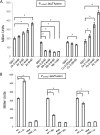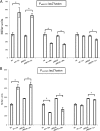EfaR is a major regulator of Enterococcus faecalis manganese transporters and influences processes involved in host colonization and infection
- PMID: 23297382
- PMCID: PMC3584879
- DOI: 10.1128/IAI.06377-11
EfaR is a major regulator of Enterococcus faecalis manganese transporters and influences processes involved in host colonization and infection
Abstract
Metal ions, in particular manganese, are important modulators of bacterial pathogenicity. However, little is known about the role of manganese-dependent proteins in the nosocomial pathogen Enterococcus faecalis, a major cause of bacterial endocarditis. The present study demonstrates that the DtxR/MntR family metalloregulator EfaR of E. faecalis controls the expression of several of its regulon members in a manganese-dependent way. We also show that efaR inactivation impairs the ability of E. faecalis to form biofilms, to survive inside macrophages, and to tolerate oxidative stress. Our results reveal that EfaR is an important modulator of E. faecalis virulence and link manganese homeostasis to enterococcal pathogenicity.
Figures







References
-
- Murray BE, Weinstock GM. 1999. Enterococci: new aspects of an old organism. Proc. Assoc. Am. Physicians. 111: 328–334 - PubMed
-
- Richards MJ, Edwards JR, Culver DH, Gaynes RP. 2000. Nosocomial infections in combined medical-surgical intensive care units in the United States. Infect. Control Hosp. Epidemiol. 21: 510–515 - PubMed
-
- Mohamed JA, Huang DB. 2007. Biofilm formation by enterococci. J. Med. Microbiol. 56: 1581–1588 - PubMed
-
- Agranoff DD, Krishna S. 1998. Metal ion homeostasis and intracellular parasitism. Mol. Microbiol. 28: 403–412 - PubMed
-
- Jakubovics NS, Jenkinson HF. 2001. Out of the iron age: new insights into the critical role of manganese homeostasis in bacteria. Microbiology 147: 1709–1718 - PubMed
Publication types
MeSH terms
Substances
Associated data
- Actions
LinkOut - more resources
Full Text Sources
Other Literature Sources
Molecular Biology Databases

